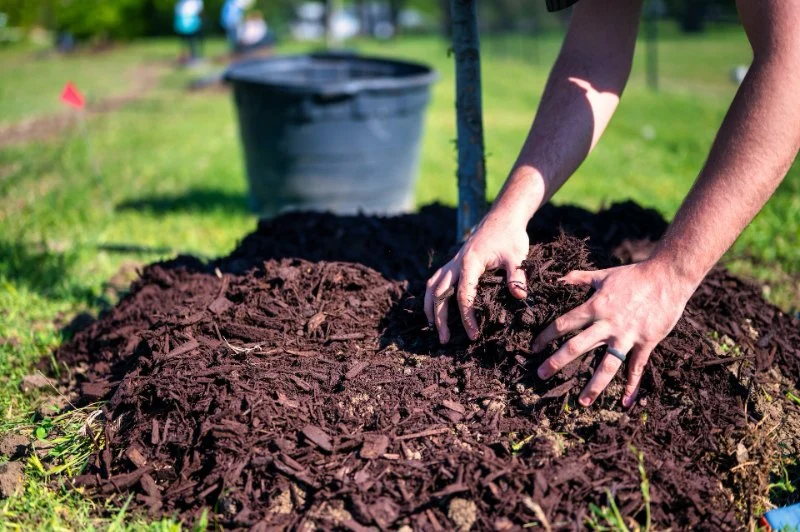
1. Why Landscaping Mulch Matters for Pest Control
Landscaping mulch is more than just a decorative element for your garden; it plays a significant role in pest control. The type of mulch you choose can either attract or deter pests in your outdoor spaces. By understanding the relationship between mulch and pests, you can make an informed decision to create a healthier, pest-free environment in your yard. In this article, we’ll explore how different mulch types affect pest attraction and provide tips on selecting the best mulch for your landscape.

Oldham Chemicals Co Inc
476 Flowing Wells Rd # G1, Augusta, GA 30907, USA
2. The Role of Mulch in Pest Attraction
Mulch provides a variety of benefits for landscaping, including moisture retention, temperature regulation, and weed suppression. However, it also creates an environment where pests can thrive. Understanding how mulch interacts with pests is key to preventing unwanted infestations.
2.1. Mulch as Shelter and Habitat for Pests
Mulch can serve as a habitat for various pests, including insects and rodents. The layer of mulch provides shelter, moisture, and a food source for pests, making it an ideal environment for them to live and breed. This is particularly true for organic mulches, which break down over time and provide nourishment for pests.
2.2. Mulch that Attracts Pests
Some types of mulch are more likely to attract pests than others. For example, mulch made from wood chips or bark may attract termites, ants, and other insects due to their natural decomposing properties. Similarly, mulches that retain moisture for extended periods can attract rodents seeking a cool and damp place to nest.
2.3. Mulch that Deters Pests
On the other hand, some types of mulch are more resistant to pest attraction. Inorganic mulches, such as gravel, rubber, and stone, do not break down and are less likely to attract pests. Additionally, mulches like cedar or cypress are known to have natural oils that act as insect repellents, helping to keep pests at bay.
3. Common Types of Mulch and Their Effect on Pest Attraction
Now that we understand the general relationship between mulch and pests, let's take a closer look at some of the most common mulch types and how they affect pest attraction:
3.1. Organic Mulches
Organic mulches, such as wood chips, bark, straw, and leaves, are made from natural materials that decompose over time. While they offer numerous benefits for your garden, they can also create a welcoming environment for pests.
3.1.1. Wood Chips and Bark
Wood chips and bark are popular choices for mulch because they are aesthetically pleasing and provide excellent moisture retention. However, these materials can attract termites, ants, and other wood-damaging pests. The decomposition process also creates a fertile environment for pests like fungi, mold, and slugs, which may become a nuisance in your garden.
3.1.2. Straw and Hay
Straw and hay are commonly used as mulch in vegetable gardens due to their ability to suppress weeds and retain moisture. However, these organic mulches can also attract rodents, such as mice and voles, which like to nest in the dense layers. Additionally, straw and hay may harbor pests like aphids and mites, which can affect your plants.
3.2. Inorganic Mulches
Inorganic mulches, such as rubber, gravel, and stones, are less likely to attract pests since they do not break down and provide nourishment for them. These mulches are often used in areas where pest control is a priority, and they provide a more permanent solution for landscaping. However, inorganic mulches do not provide the same soil benefits as organic mulches.
3.2.1. Rubber Mulch
Rubber mulch is made from recycled tires and is a long-lasting, low-maintenance option for landscaping. It does not decompose, making it less attractive to pests. Additionally, it helps with moisture retention and provides a clean, uniform look. However, rubber mulch can get very hot in the summer, which could be a drawback for certain plants.
3.2.2. Gravel and Stone Mulch
Gravel and stone mulches are excellent choices for areas where you want to prevent pest attraction. These materials do not decompose, which means they don’t create a habitat for insects or rodents. Gravel and stone also help with drainage, making them ideal for areas prone to water pooling. However, these types of mulches can be difficult to walk on and may not provide the same aesthetic appeal as organic mulches.
3.3. Mulches with Natural Pest Repellents
Some types of organic mulches, like cedar or cypress, are naturally resistant to pests due to the oils and compounds they contain. These mulches can be particularly effective in keeping insects away from your garden without the use of chemicals.
3.3.1. Cedar Mulch
Cedar mulch is well-known for its natural pest-repellent properties. The oils in cedar wood naturally repel insects like ants, termites, and moths, making it an excellent choice for gardens in areas prone to these pests. Cedar mulch also has a pleasant aroma, making it a popular choice for landscaping.
3.3.2. Cypress Mulch
Like cedar, cypress mulch contains natural oils that repel insects. It is a durable, long-lasting mulch that works well for pest control in flower beds and around shrubs. However, it’s important to note that cypress mulch is often harvested from environmentally sensitive areas, so it may not be the most sustainable option.
4. How to Choose the Right Mulch for Your Garden
Choosing the right mulch for your garden depends on your goals for both aesthetics and pest control. Here are a few tips to help you make the best choice:
4.1. Consider Your Pest Problems
If you’ve had problems with pests like termites, ants, or rodents, it may be wise to choose mulch options that are less likely to attract them. Inorganic mulches like gravel, stone, or rubber are good options for minimizing pest attraction, while cedar and cypress mulches can provide natural pest-repelling properties.
4.2. Think About Maintenance
Organic mulches require more maintenance as they decompose over time and may need to be replenished every year. In contrast, inorganic mulches require less maintenance but do not provide the same soil benefits. Consider how much time and effort you are willing to put into upkeep when choosing your mulch.
4.3. Assess Environmental Impact
Some mulch options, like rubber mulch, are made from recycled materials, which can be a sustainable choice. However, organic mulches like wood chips, straw, and leaves are biodegradable and can improve soil quality as they break down, benefiting plant growth in the long run.
5. Case Study: Mulch Choice and Pest Control Success
John, a homeowner in Texas, struggled with ants invading his garden every year. After trying various pest control methods, he decided to switch to cedar mulch for his flower beds. The natural oils in the cedar mulch effectively kept the ants at bay, and he noticed fewer pest problems the following season. Not only did the cedar mulch reduce pests, but it also enhanced the visual appeal of his garden with its pleasant aroma and attractive appearance.
6. Conclusion
Landscaping mulch plays a crucial role in pest control. By choosing the right type of mulch, you can create a garden that is not only aesthetically pleasing but also free from pests. Whether you opt for natural pest-repelling mulches like cedar and cypress or choose inorganic options like gravel and rubber, your choice of mulch can make a significant difference in pest attraction. For more information on pest control and to find the best products for your garden, visit PestControlHub for expert advice and solutions.








 Wildlife Resolutions4.0 (443 reviews)
Wildlife Resolutions4.0 (443 reviews) Pest Marshals of Toledo5.0 (2 reviews)
Pest Marshals of Toledo5.0 (2 reviews) LS Rodent Proofing & Pest Control Service5.0 (4 reviews)
LS Rodent Proofing & Pest Control Service5.0 (4 reviews) Best Termite & Pest Control4.0 (16 reviews)
Best Termite & Pest Control4.0 (16 reviews) Varment Guard Wildlife Services5.0 (28 reviews)
Varment Guard Wildlife Services5.0 (28 reviews) Pestban Inc4.0 (394 reviews)
Pestban Inc4.0 (394 reviews) How to Use Monitors to Detect Pest Entry: A Comprehensive Guide
How to Use Monitors to Detect Pest Entry: A Comprehensive Guide How to Predict Which Pests Will Invade Next – Smart Pest Forecasting for the U.S.
How to Predict Which Pests Will Invade Next – Smart Pest Forecasting for the U.S. How to Conduct a Pest Risk Assessment at Home – Expert Guide
How to Conduct a Pest Risk Assessment at Home – Expert Guide How to Block Pest Entry Around Deck Joists: Effective Solutions
How to Block Pest Entry Around Deck Joists: Effective Solutions How to Safely Use Fumigation Methods: A Comprehensive Guide for Homeowners
How to Safely Use Fumigation Methods: A Comprehensive Guide for Homeowners Why Pests Are More Active After Rain: Understanding the Link Between Weather and Pest Behavior
Why Pests Are More Active After Rain: Understanding the Link Between Weather and Pest Behavior